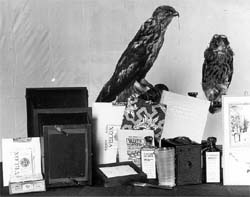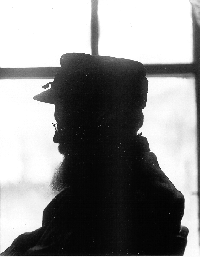
Frank Sadorus
studied photography by reading magazines and books and experimenting
with supplies he ordered by mail. He made notes about each photograph
he took detailing the exposure, weather and light conditions, and the
chemicals and papers he used to develop his prints. Frank's elder brother
Enos also had an interest in photography; it's possible that Frank learned from
him initially and added to his knowledge from books.
He read about
photography, art, science, secretarial practice,and taxidermy. The range
of reading matter, which included novels, suggests that he had an inclusive
and curious mind. It also suggests how he passed the long winter nights.
Frank
Sadorus saw magazine prints of photographs by pictorialist and impressionist
photographers, but he was a thousand miles and an entire subculture
away from New York. His style was more in tune with the "straight"photography
that followed Steiglitz. He was clearly influenced by the snapshot photography
that revolutionized the world through Eastman Kodak.
Supplies and
Education
Frank ordered his photographic supplies from St. Louis. Most of his
plate glass negatives came from the Seed Dry Plate Company. He used
Velox paper for printing his pictures. To keep up on photographic techniques, he read the Photographic
Times, Camera Craft, Wilson's Photographic Magazine, Northern Photo
News, St. Louis and Canadian Photographer, Bulletin of Photography,
Photo-Era: the American Journal of Photography, and some annuals
and books.
Photographic books
in Frank's collection include: Picture Making for Pleasure and Profit,
The Kodak on the Farm, The Modern Way in Picture Making, Faults in Negatives,
Standard of Perfection, and Cramer's Manual of Negative Making and Formulas.
Other manuals include Bromide Enlarging with a Kodak, By Flashlight,
Photographic Facts and Fallacies, and Development Simplified.

Sunshine and
Shadow
Sadorus was very sensitive to light and shot at many different times
of day to capture different effects. He
was very interested in the qualities of light and shadow. This was reflected
in some of the titles he gave his landscapes and references to his "complete
sunshine system,". The reference could also refer to his sense of humor,
exemplified in his double exposures, visual puns, and written notations
on prints.
Many of his portraits
demonstrated chiaroscuro lighting, picking up the subtler darker tones
of shadow. He also experimented with double exposures,
often with a pun in mind.
He lit some of
his still lifes from several angles. Others
appear as if in natural light with sharp detail that gives a sense of
portrait to them.

